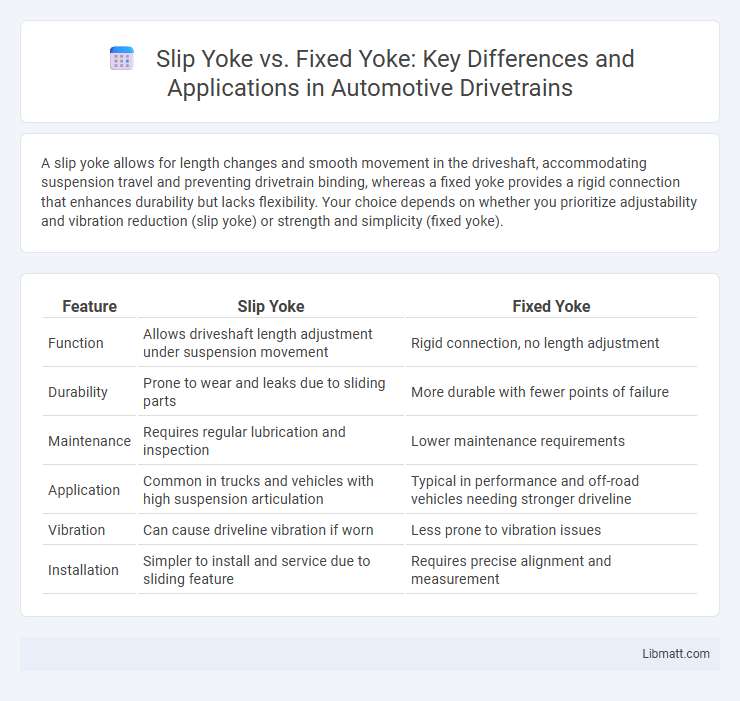A slip yoke allows for length changes and smooth movement in the driveshaft, accommodating suspension travel and preventing drivetrain binding, whereas a fixed yoke provides a rigid connection that enhances durability but lacks flexibility. Your choice depends on whether you prioritize adjustability and vibration reduction (slip yoke) or strength and simplicity (fixed yoke).
Table of Comparison
| Feature | Slip Yoke | Fixed Yoke |
|---|---|---|
| Function | Allows driveshaft length adjustment under suspension movement | Rigid connection, no length adjustment |
| Durability | Prone to wear and leaks due to sliding parts | More durable with fewer points of failure |
| Maintenance | Requires regular lubrication and inspection | Lower maintenance requirements |
| Application | Common in trucks and vehicles with high suspension articulation | Typical in performance and off-road vehicles needing stronger driveline |
| Vibration | Can cause driveline vibration if worn | Less prone to vibration issues |
| Installation | Simpler to install and service due to sliding feature | Requires precise alignment and measurement |
Introduction to Slip Yoke and Fixed Yoke
Slip yokes allow for axial movement of the driveshaft, accommodating changes in length due to suspension travel, while fixed yokes provide a solid connection without any sliding capability. Your vehicle's driveline setup determines whether a slip yoke or fixed yoke is more suitable, impacting driveline alignment and vibration. Understanding the functional differences helps optimize performance and durability in various off-road or towing conditions.
What is a Slip Yoke?
A slip yoke is a type of drivetrain component that allows the driveshaft to move in and out of the transmission or transfer case, accommodating changes in length due to suspension movement or vehicle load. This telescoping mechanism helps prevent drivetrain binding and reduces stress on other parts by maintaining proper alignment and engagement of the driveshaft. Commonly used in vehicles with solid rear axles and leaf spring suspensions, slip yokes improve driveline flexibility and durability.
What is a Fixed Yoke?
A fixed yoke is a type of drivetrain component that connects the driveshaft directly to the transmission or differential without allowing axial movement. Unlike a slip yoke, it uses a universal joint to accommodate vehicle movement and suspension travel while maintaining a stable connection. Understanding your fixed yoke's role helps ensure optimal drivetrain performance and reduces the risk of vibrations or premature wear.
Key Differences Between Slip Yoke and Fixed Yoke
Slip yokes allow axial movement to accommodate changes in driveshaft length during suspension travel, preventing drivetrain binding, whereas fixed yokes provide a rigid connection without slip, requiring a slip spline for length adjustment. Slip yokes are common in vehicles with leaf springs and solid rear axles due to their flexibility, while fixed yokes are preferred in coil spring or independent suspension setups for enhanced durability and reduced vibration. The choice between slip yoke and fixed yoke affects drivetrain longevity, alignment precision, and maintenance requirements.
Advantages of Slip Yoke
Slip yokes offer superior flexibility in driveline movement by accommodating shaft length changes during suspension travel, reducing stress on drivetrain components. This design minimizes the risk of joint binding and vibration, enhancing overall vehicle longevity and performance. Their ease of installation and maintenance also makes slip yokes a preferred choice for off-road and high-performance applications.
Benefits of Fixed Yoke
Fixed yokes provide enhanced durability and stability due to their secure, permanent attachment, reducing the risk of driveline vibrations and wear. You benefit from improved power transfer efficiency and lower maintenance requirements compared to slip yokes, which can suffer from contamination and frequent adjustments. Fixed yokes also contribute to better vehicle handling and a smoother driving experience, especially in off-road or heavy-duty applications.
Applications of Slip Yoke in Driveline Systems
Slip yokes are widely used in driveline systems to accommodate changes in length caused by suspension movement or axle articulation, ensuring smooth power transfer and preventing drivetrain binding. They are essential in off-road vehicles, trucks, and SUVs where varying angles and distances between components occur frequently during operation. Your driveline benefits from slip yokes by maintaining flexibility and reducing wear on the transmission and driveshaft components.
Common Uses for Fixed Yoke Assemblies
Fixed yoke assemblies are commonly used in heavy-duty trucks, off-road vehicles, and industrial machinery due to their durability and ability to handle high torque loads. These assemblies provide a secure connection with minimal play, making them ideal for applications requiring precise driveline alignment and consistent power transfer. You can rely on fixed yoke setups for improved stability in demanding driving conditions and long-term reliability.
How to Choose Between Slip Yoke and Fixed Yoke
Choosing between a slip yoke and a fixed yoke depends on vehicle application and maintenance preferences. Slip yokes allow for easier driveline length adjustments and accommodate suspension travel, making them ideal for off-road or lifted trucks. Fixed yokes provide a more durable, balanced driveline with reduced vibrations, better suited for high-performance or heavy-duty vehicles requiring minimal maintenance.
Final Thoughts on Slip Yoke vs. Fixed Yoke
Slip yokes offer flexibility by allowing movement within the driveshaft, reducing stress on drivetrain components during suspension travel. Fixed yokes provide a more rigid connection, improving drivetrain stability and minimizing vibrations at high speeds. Your choice depends on your vehicle's suspension design and performance needs, balancing durability with smooth operation.
slip yoke vs fixed yoke Infographic

 libmatt.com
libmatt.com